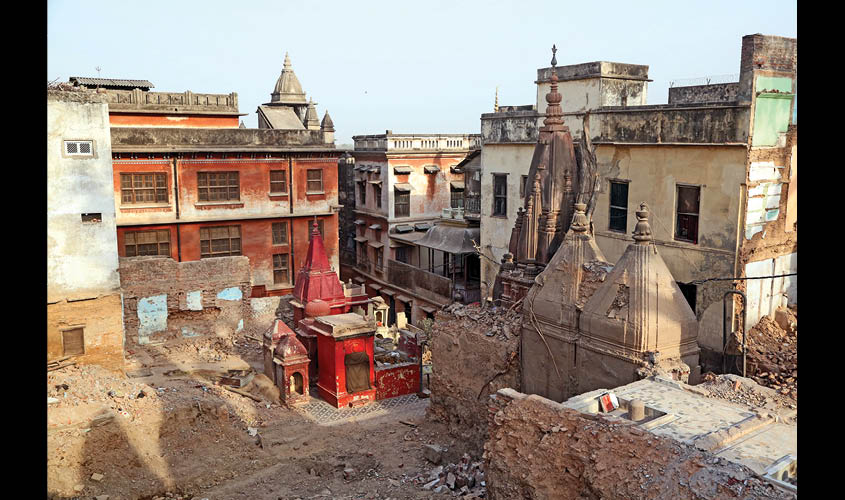‘We have paid every single person who has been shifted out of this place, including the illegal encroachers.’
Varanasi: In the heart of the ancient city of Varanasi, where the Kashi Vishwanath temple is located, space is being created to build a wide corridor connecting the temple with the ghats. A dream project of Prime Minister Narendra Modi, it is being executed by the Uttar Pradesh government. Making the corridor requires levelling several houses and shops surrounding the temple, thus relocating the people inhabiting there. 53 temples have been discovered from inside the demolished houses. These are now being restored. Last week in Varanasi, The Sunday Guardian spoke to the CEO of Shri Kashi Viswanath Temple Trust, Vishal Singh, who is in charge of implementing the project on the ground. According to the data provided by him, Rs 262 crore has been paid to owners of buildings that were demolished and another Rs 16.54 crore to the tenants, some of them even illegal encroachers. Since the temple is located in a congested area, routes are being cleared and there are plans to build a ropeway and also a waterway to the corridor, which has been envisaged as an open green space with facilities for the public, including libraries, etc. Excerpts from the interview:

Q: Why this corridor and how much disruption has it caused to people’s lives and how have you handled that? There is some anger on the ground, so how are you handling
A: The idea of creating more space around the temple and various routes reaching to the temple, this was envisaged

Q: There have been complaints from tenants that their landlords have—perhaps those who were subletting these places—have thrown them out overnight.
A: That is completely wrong. We have complete record of how many families and shopkeepers we have paid. We have paid tenants and even illegal encroachers. The idea was not to take away anyone’s shelter without sufficiently compensating them.
Q: There have been complaints about temples being demolished.
A: No, not a single temple has been demolished. Every demolition has been recorded and we have time lag videos, we have clicked photos of every house and videographed them. Even during demolition if we come across any temple, immediately we stop the work. We then chisel out everything from the temple using manual labour.
People of Kashi say that the temples were covered because they wanted to save these temples from those who wanted to demolish them. The second theory is that these were the houses of Muslims, as Aurangzeb, after the demolition of the main temple, gave this place to his soldiers and they created this whole Lahori Tola that we have removed. There are different types of stories but the truth is they (those who stayed there) were all Hindus; the construction that had happened there was clearly showing need for space. Temples were used as kitchens and shops. One temple belonged to a Mishra family. When I entered the house I saw there was this huge beautiful temple inside and it was being used as storage space for the lassi shop he had in front of the house.

Q: How long will it take for this project to be completed?
A: My idea is to give it to the public by June 2021. We have to start the construction. We are not able to float tenders because of the model code of conduct. Once it’s over, by the end of May, by June we will float tenders for construction. Space has been created already. Drawing has been approved. So we have to just get the DPR (Detailed Project Planning) which is being made. Because we have discovered so many temples and they have to be included in the DPR and beautification and reconstruction wherever needed for the temples have to be done. Earlier this was not in the plan. So that’s why we have to modify our DPR. And once it is modified we will take it to the Cabinet and start floating tenders from the first week of June.
Q: Considering all these people are being shifted out, what have you done for their counselling and rehabilitation?
A: We have paid the owners double the price and if they agreed on anything less than that we have done that. Many have even donated their houses as they didn’t want money for that. The third category comprises people who are being shifted out. We have taken care of every need that they have, apart from paying them money, including taking care of the psychological pressure that they might have felt. So we had counsellors to counsel them. If there was a medical need we have treated them. There is a lady who has sold her house but we are not vacating her because she is not keeping well. We are treating her at SGPI in Lucknow. She has been operated on. We are taking a humanitarian approach as much as possible. We have got students admitted to different schools. I have referred them for the Chief Minister’s Relief Fund if needed. So everything has been done. So no pressure has been applied on people to vacate the houses.
Q: Are you coordinating with the Prime Minister’s Office regarding this?
A: No. It’s a state government project and I am implementing it (on behalf of the state government). It is completely funded by the state government.

